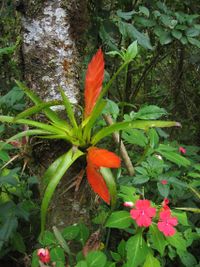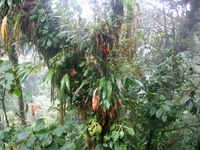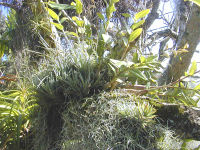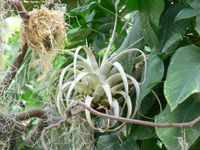Epiphyte



An epiphyte is a plant that grows upon another plant (such as a tree) non-parasitically or sometimes upon some other object (such as a building or a telegraph wire), derives its moisture and nutrients from the air and rain and sometimes from debris accumulating around it, and is found in the temperate zone (as many mosses, liverworts, lichens and algae) and in the tropics (as many ferns, cacti, orchids, and bromeliads) — also called air plants."[1]
Epiphyte is one of the subdivisions of the Raunkiær system. The term most commonly refers to higher plants, but epiphytic bacteria, fungi (epiphytic fungi), algae, lichens, mosses, and ferns exist as well. The term epiphytic derives from the Greek epi- (meaning 'upon') and phyton (meaning 'plant'). Epiphytic plants are sometimes called "air plants" because they do not root in soil. However, there are many aquatic species of algae, including seaweeds, that are epiphytes on other aquatic plants (seaweeds or aquatic angiosperms).
Epiphytic organisms usually derive only physical support and not nutrition from their host, though they may sometimes damage the host. Parasitic and semiparasitic plants growing on other plants (mistletoe is well known) are not "true" epiphytes (a designation usually given to fully autotrophic epiphytes), but are still epiphytic in habit.
Epiphytic plants use photosynthesis for energy and (where non-aquatic) obtain moisture from the air or from dampness (rain and cloud moisture) on the surface of their hosts. Roots may develop primarily for attachment, and specialized structures (for example, cups and scales) may be used to collect or hold moisture.
Epiphytic plants attached to their hosts high in the canopy have an advantage over herbs restricted to the ground where there is less light and herbivores may be more active.
Epiphytic plants are also important to certain animals that may live in their water reservoirs, such as some types of frogs and arthropods. The best-known epiphytic plants include mosses, orchids, and bromeliads such as Spanish moss (of the genus Tillandsia), but epiphytic plants may be found in every major group of the plant kingdom. 89% of epiphyte species (about 24,000) are flowering plants. The second largest group are the leptosporangiate ferns, with about 2800 species (10% of epiphytes). The third largest group is clubmosses, with 190 species, followed by a handful of species in each of the spikemosses, other ferns, Gnetales, and cycads.[2]
Assemblages of large epiphytes occur most abundantly in moist tropical forests, but mosses and lichens occur as epiphytes in almost any environment with trees.

Some epiphytic plants are large trees that begin their lives high in the forest canopy. Over decades they send roots down the trunk of a host tree eventually overpowering and replacing it. The strangler fig and the northern rātā (Metrosideros robusta.) of New Zealand are examples of this. Epiphytes that end up as free standing trees are also called hemiepiphytes.
In Europe there are no dedicated epiphytic plants using roots, but rich assemblages of mosses and lichens grow on trees in damp areas (mainly the western coastal fringe), and the common polypody fern grows epiphytically along branches. Rarely, grass, small bushes or small trees may grow in suspended soils up trees (typically in a rot-hole).
The first important monograph on epiphytic plant ecology was written by A.F.W. Schimper (Die Epiphytische Vegetation Amerikas, 1888).
See also
- Epiphyllum - a genus of orchid cacti
- Parasitic plant
- Raunkiær plant life-form
References
- ↑ Webster's Third New International Dictionary of the English Language, Unabridged. (1976). Vol. I, p. 764. Encyclopædia Britannica, Inc. Chicago.
- ↑ Eric Schuettpelz (2007), The evolution and diversification of epiphytic ferns, Duke University PhD thesis, http://dukespace.lib.duke.edu/dspace/bitstream/10161/181/1/D_Schuettpelz_Eric_a_052007.pdf